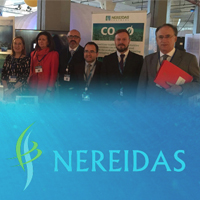news
CIMNE Nature and FWN visit the desalination plant of El Prat de Llobregat
In July, CIMNE Nature's Group and FWN teams visited the desalination plant's facilities, located at Llobregat river mouth and operated by Aigües Ter Llobregat (ATLL). The desalination plant, which started operating in summer 2009, is the biggest in Europe for drinking water production.

From left to right: Jaume Roquet (Chief Operating Officer of the firm ATLL), Pedro Arnau (CIMNE Nature Group), Javier Soraluce (FWN), Isabel Gandullo (ACA), Carlos Miguel Centeno (Chief of the desalination plant ATLL), Naeria Navarro (FWN), Jose María Martínez (FWN) and Fernando Valero (Jefe R&D+i ATLL).
The plant was built in order to increase the water availability for supplying more than 120 towns, for more than 4,5 millions inhabitants. It is a modular desalination plant that can produce up to 2,300 liters of fresh water per second from seawater by reverse osmosis.
After the presentation of the new Cool Steam technology developed by FWN and CIMNE Nature Group, the team of ATLL (licensee of Generalitat de Catalunya) showed all the processes to which seawater is subjected within its cycle along the plant.
.jpg)
Reverse osmosis process facilities. The seawater to be treated is flown through the central green pipes. Engines propel seawater to the filters (blue). Filters cleaning agents are provided through purple pipes. Rejected brine is collected inside the central grey pipe after passing through the pressure exchangers. Permeate freshwater flows along blue pipes to remineralization station.
Seawater collection is carried out at 30 metres depth and 2,2 kilometres away from the coast and it is driven until the pumping station located on the beach, which propels seawater to the desalination plant located 3 kilometres away. Once inside the plant, seawater is pre-treated by flocculation-flotation process and run through open and closed filters.
After this pre-treatment, seawater is subjected to reverse osmosis to remove salts from water. Seawater is run through semi-permeable membranes, separating 45 litres of freshwater and 55 of brine (which constitutes the reject stream) from every 100 litres of feed water. To run the reverse osmosis process, high-pressure pumps (69 Bar) are used.
After this process, freshwater is remineralized, by providing some minerals for it to be completely potable according with the legislation in force. The plant has pressure exchangers which allow an energy saving of around 50%.








